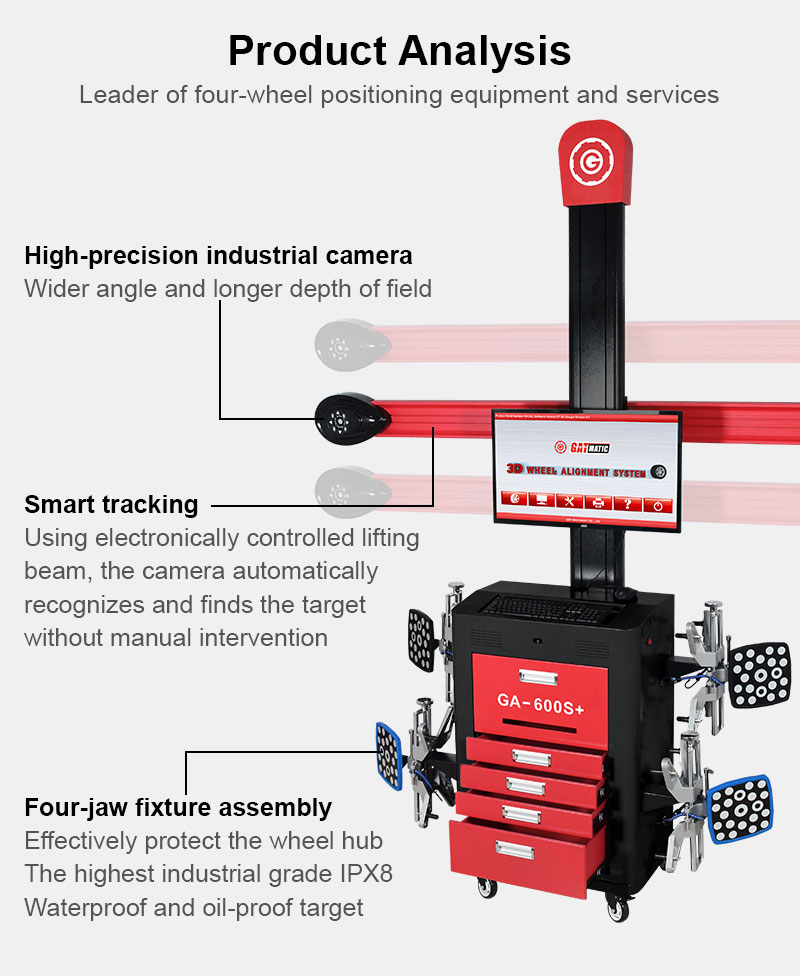Recent Blog
-
CCD Alignment Systems VS. 3D Alignment Systems
2025-04-08 -
What are the main differences between 2D and 3D wheel alignment systems
2025-03-26 -
Is Touchless Wheel Alignment Right for You? Factors to Consider
2025-03-19 -
The Future of Automotive Service: Exploring Touchless Wheel Alignment Technology
2025-03-13
How 3D Wheel Aligners Improve Driving Safety and Stability
In the ever-evolving landscape of automotive technology, one aspect that often goes unnoticed but plays a crucial role in driving safety and stability is wheel alignment. As technology progresses, traditional methods are making way for more advanced solutions, with 3D wheel aligners emerging as a game-changer in the automotive industry.
I. Understanding Wheel Alignment
Wheel alignment involves adjusting the angles of a vehicle’s wheels to ensure they are perpendicular to the ground and parallel to each other. This process is vital for optimal vehicle performance, affecting factors such as tire wear, fuel efficiency, and most importantly, driving safety.
II. Traditional Wheel Alignment Methods
Historically, wheel alignment was a manual and somewhat cumbersome process. Technicians relied on rudimentary tools and measurements, leading to limitations in accuracy and efficiency. This raised concerns about the overall effectiveness of traditional wheel alignment methods.
III. Enter 3D Wheel Aligners
The advent of 3D wheel aligners has revolutionized how we approach wheel alignment. These sophisticated devices utilize cutting-edge technology to provide unparalleled precision and accuracy, addressing the shortcomings of traditional methods.
IV. Precision and Accuracy of 3D Wheel Aligners
Unlike manual methods, 3D wheel aligners leverage advanced imaging technology to create a three-dimensional model of a vehicle’s alignment. This level of precision ensures that adjustments are made with utmost accuracy, directly impacting the safety and stability of the vehicle on the road.
V. Real-Time Adjustments
One of the standout features of 3D wheel aligners is their ability to make real-time adjustments. This means that as soon as an issue is identified, it can be corrected on the spot. This real-time responsiveness contributes significantly to the stability of the vehicle, reducing the risk of accidents related to alignment issues.
VI. User-Friendly Interface
Despite their advanced technology, 3D wheel aligners boast a user-friendly interface. Technicians can easily navigate through the system, making the alignment process more efficient. This not only benefits the professionals performing the alignment but also contributes to overall customer satisfaction.
VII. Cost-Effectiveness
While the initial investment in 3D wheel aligners might seem substantial, the long-term cost benefits are undeniable. The precision and efficiency of these devices lead to reduced maintenance costs, extended tire life, and improved fuel efficiency – all of which contribute to a safer driving experience.
VIII. Advanced Diagnostics
In addition to alignment, 3D wheel aligners offer advanced diagnostic features. These features enable technicians to identify issues beyond simple misalignment, contributing to overall vehicle health. Addressing these issues proactively enhances driving safety and prevents potential breakdowns.
IX. The Role in Tire Longevity
Proper wheel alignment directly impacts tire wear. With 3D wheel aligners ensuring optimal alignment, tires experience less wear and tear, ultimately extending their lifespan. This not only saves money for vehicle owners but also contributes to safer driving conditions.
X. Integration with Modern Vehicles
As vehicles become more technologically advanced, the need for alignment solutions that can adapt to modern features is crucial. 3D wheel aligners seamlessly integrate with various vehicle technologies, including advanced driver assistance systems (ADAS), ensuring alignment precision in today’s sophisticated automotive landscape.
XI. Industry Adoption and Trends
The automotive industry is witnessing a rapid adoption of 3D wheel aligners. Service centers and technicians are recognizing the benefits these devices bring to the table, leading to a growing trend in the use of advanced alignment technology.
XII. Consumer Experiences and Testimonials
Real-world experiences and testimonials from both vehicle owners and technicians emphasize the positive impact of 3D wheel aligners on driving safety. Stories of improved stability, enhanced performance, and reduced incidents related to misalignment provide compelling evidence of the effectiveness of this technology.
XIII. Challenges and Considerations
While 3D wheel aligners offer significant advantages, it’s essential to address potential challenges or considerations. Factors such as initial costs, training requirements, and the need for regular updates should be taken into account. However, these challenges can be mitigated with strategic planning and proper implementation.
Conclusion
In conclusion, 3D wheel aligners have emerged as a transformative technology in the automotive industry, significantly improving driving safety and stability. The precision, real-time adjustments, and integration with modern vehicles make them a valuable asset for both service centers and vehicle owners. As we continue to embrace innovation, the role of 3D wheel aligners in enhancing the overall driving experience cannot be overstated.
FAQs
1. Are 3D wheel aligners suitable for all types of vehicles?
Yes, 3D wheel aligners are designed to accommodate a wide range of vehicles, from compact cars to larger trucks.
2. How often should wheel alignment be performed using 3D technology?
It is recommended to perform wheel alignment using 3D technology annually or whenever you notice signs of misalignment, such as uneven tire wear.
3. Can 3D wheel aligners detect issues beyond simple misalignment?
Yes, 3D wheel aligners come equipped with advanced diagnostic features that can identify issues beyond basic misalignment, contributing to overall vehicle health.
4. Do 3D wheel aligners work with older vehicle models?
Yes, many 3D wheel aligners are versatile and compatible with both modern and older vehicle models.
5. How do 3D wheel aligners contribute to fuel efficiency?
By ensuring proper alignment, 3D wheel aligners reduce rolling resistance, leading to improved fuel efficiency over time.
Get Access Now: https://www.gat-matic.com
Describe Your Needs In Detail!
We will carefully evaluate your needs and give professional solutions.



